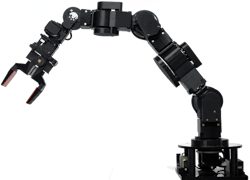Revisions made to the anatomy of Energid Technology’s drones will enable these UAVs to fly around and aid astronauts in their day-to-day work at NASA’s International Space Station. By giving drones lightweight, extremely dexterous arms, the automatic free-fliers will offer much more than their current roles as flying sensors and camera platforms.
The latest robotic arm by Energid’s subsidiary, Robai, weighs only 300 grams and has nine degrees of motion for fluid motion. The NASA drones will leverage the adaptive qualities of Energid’s Actin software to perform tasks such as accurately placing sensors for monitoring different machinery, or staging workspaces in a microgravity environment. The drones will be able to use the arms as they maneuver around the microgravity space station, pushing off walls with optimized strength control and joint movements.
The following video shows an example of an Actin-software robotic arm, developed by Energid and Adept Technology, displaying a wide range of motion. Although it consists of two multi-jointed robotic arms, the arm is able to synchronize the movement of all its joints so that they move with optimum efficiency to avoid a stationary object constraint (the chair), perform a task (picking up the chip), and follow a moving point constraint in 3D space. These constraints can be viewed and controlled in a virtual environment, shown on the PC screen at the end of the video. Changing the perspective of the screen controls the depth of the robot’s movements.
Watch the multi-jointed arm operate in the following video on Engineering TV:
Energid’s new drone arms will possess a range of innovative features designed specifically for use on flying objects, rather than on platforms with a fixed location. The drones must be able to maneuver throughout the ISS without ruining equipment, and land when they are inactive or perform a task without hovering, in order to save energy. The arms are expected to weigh less than a pound, and programming should not require intense programming skills. Task management is controlled though a graphical or drag-and-drop interface, but can also be tweaked with C++ coding.
About the Author
Leah Scully
Associate Content Producer
Leah Scully is a graduate of The College of New Jersey. She has a BS degree in Biomedical Engineering with a mechanical specialization. Leah is responsible for Machine Design’s news items that cover industry trends, research, and applied science and engineering, along with product galleries. Visit her on Facebook, or view her profile on LinkedIn.
